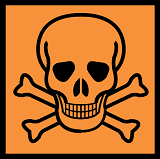 Explosive atmospheres can be caused by flammable gases, mists, vapours or combustible dusts. If there is enough of a substance that is mixed with the air, then all it needs is a source of ignition to cause an explosion.
Explosive atmospheres can be caused by flammable gases, mists, vapours or combustible dusts. If there is enough of a substance that is mixed with the air, then all it needs is a source of ignition to cause an explosion.
Each year, hundreds of people are injured at work by flammable substances accidentally catching fire or exploding. Companies and businesses who are involved with using or creating chemicals, vapours, liquids, gases, solids or dusts that can readily burn or explode is hazardous.
The effects of an explosion or a fire in the workplace can have devastating affects upon the employees and employer including, lost of lives, injuries, damage to the property and environment.
If the workplace deals with the use or creation of these dangerous substances correctly, most fires and explosions are preventable. Employers and management have the responsibility for workplaces or other non-domestic premises to which any member of the public has access to, to be safe by adopting and teaching fire safe behaviours and procedures.
Liquids
Liquids such as petrol, fuels and solvents in industrial products such as paint, ink, adhesives and cleaning fluids, emits a flammable vapour which, when mixed with air, can ignite or explode. This process is linked to a physical test called Flashpoint. This simple test is the test of the minimum temperature at which a liquid, under specific conditions gives off sufficient flammable vapour to ignite momentarily on the application of an ignitions source. This allows them to be classed according to the fire hazard they present in normal use.
Flammable liquids are classed as:
- Extremely flammable – Liquids which have a Flashpoint lower than 0°C and a boiling point (or, in the case of boiling range, the initial boiling point) lower than or equal to 35°C.
- Highly flammable – Liquids which have a Flashpoint below 21°C but which are not extremely flammable.
- Flammable – Liquids which have a Flashpoint equal to or greater than 21°C and less then or equal to 55°C and which support combustion when tested in the prescribed manner at 55°C.
Dusts
Dusts which can form explosive atmospheres are classed as dangerous substances. Dust can be produced from everyday materials such as coal, wood, flour, grain, sugar, certain metals and synthetic organic chemicals. Many industries use materials that create dusts such as animal feed, chemical, woodworking, rubber and plastic processing and metal powders.
These materials may be raw materials, intermediates, finished or waste products. If there happens to be a source of ignition e.g. a naked flame or sparks, a cloud of combustible dust can explode violently and can cause damage and injuries.
Gases
Liquefied petroleum gas (LPG) or methane are just two of the gases which are usually stored under pressure in cylinders and bulk containers. If the release of these gases are uncontrolled, they can readily ignite or cause the cylinder to become a missile.
Solids
Materials such as plastic foam, packaging and textiles which can burn fiercely and give off dense black smoke are sometimes poisonous. There are three types of flammable solids:
- Flammable Solids – Solid substances that are easily ignited and readily combustible
- Spontaneously Combustible – Solid substances that ignite spontaneously
- Dangerous when wet – Solid substances that emit a flammable gas when wet or react violently with water.
Other fire and explosion hazards
DSEAR (Dangerous Substances and Explosives Atmospheres Regulation 2002) also covers the fire and explosion hazards that can arise from the way a substance or chemical is handled or processed, even if it hasn't been formally classed as a dangerous substance.
Many organic substances will become dangerous if they are heated to a sufficiently high temperature as they will be able to release flammable vapours or fumes that can give rise to a fire or explosion risk. Whenever any type of cutting or hot work is being carried out on a plant or equipment that may have previously contained a liquid or combustible solid it is necessary to carry out an assessment to ensure that all fire and explosion risks have been identified and controlled.
For more information about dangerous substances please see the Health and Safety Executive website. The Workplace Depot sell a range of Hazardous Storage to prevent any damage or theft of dangerous substances.
Posted in News, Health and Safety